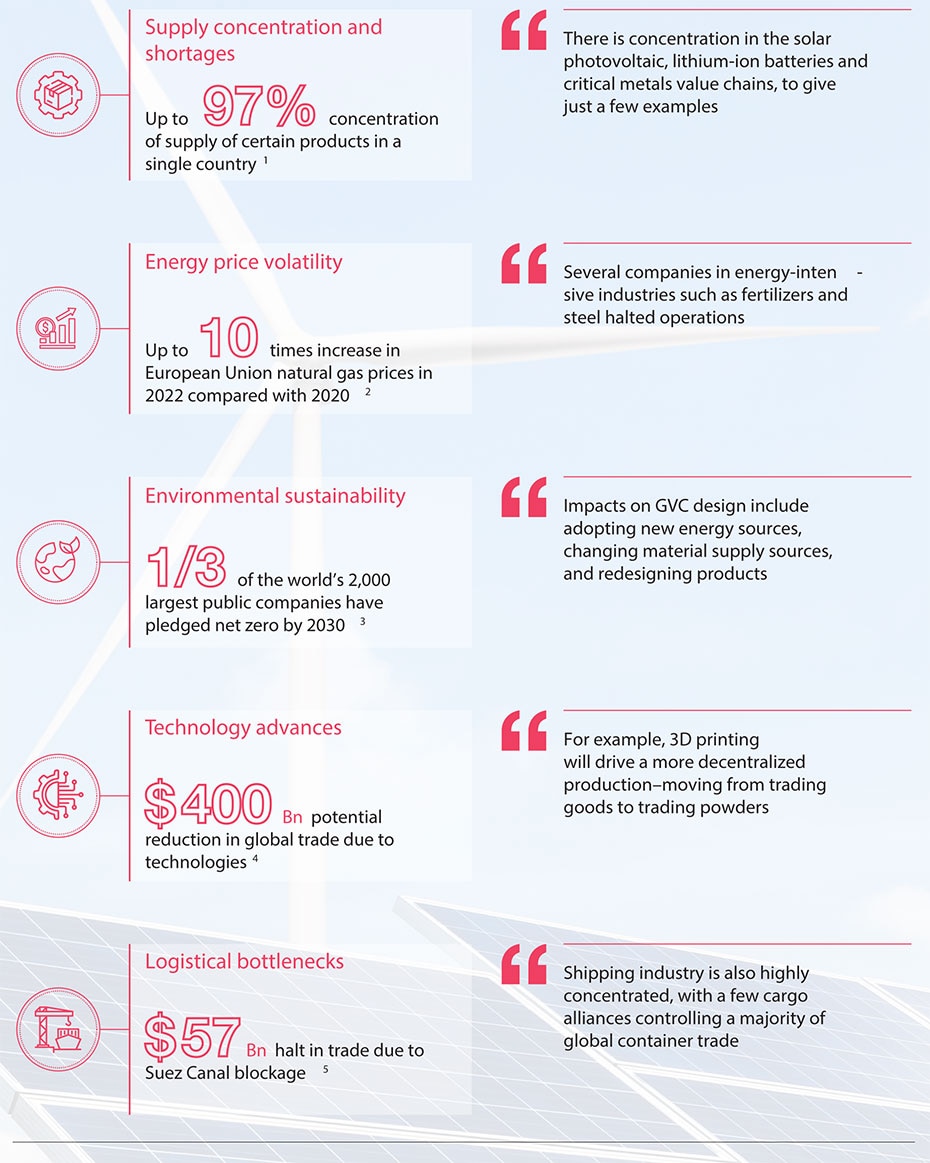{{item.title}}

Global value chains (GVCs) are being reconfigured, focusing less on cost and more on resilience, agility, and sustainability. This reconfiguration is upending traditional competitive advantages and creating opportunities for new manufacturing hubs. In the Middle East, the countries of the Gulf Cooperation Council (GCC) can seize this opportunity, as they have an abundant and cost-competitive supply of green energy, a geographically attractive location, and robust industrial and logistics infrastructure, including ports and airports. Several countries are constructing greenfield megaprojects—industrial cities built around smart and circular manufacturing. Moreover, these countries have access to young talent and an increased commitment of government spending on education, research, and innovation.
Yet the opportunity could be fleeting. GCC countries must move fast to capitalize on these emerging competitive advantages and generate a new wave of economic growth. Companies are already relocating key elements of GVCs, and other countries are competing vigorously to attract them. We have identified 11 product categories in which the GCC countries possess a clear competitive advantage. By attracting manufacturing in these product categories, GCC countries could create a global connected hub and generate an estimated US$300 billion in foreign direct investment, create 150,000 jobs, and unlock $25 billion annually in non-oil exports, as well as potentially offset 75 million tons of CO2 equivalent emissions.
Capturing the opportunity will require GCC governments to partner with one another to build multilateral value chains and join with businesses to encourage investment and competitiveness, creating the right environment for talent, innovation, and the development of the enabling infrastructure. Within a few years, GVCs will coalesce around a new set of global hubs, meaning that the region must take action now—or risk losing out.
Global value chain (GVC) is a term for the activities required to bring a product from conception to end use, across multiple firms and geographic locations. GVCs account for 70 percent of global trade and have become a dominant feature of world trade. However, many companies are reconsidering their approach to GVC design. Until roughly 2008, the decades-long globalization trend had pushed companies to build extremely complex structures with the primary focus of reducing cost; they had little end-to-end oversight or management. However, these GVCs are prone to disruption from exogenous factors such as pandemics, supply constraints, energy price volatility, and logistics bottlenecks.
1. IEA, Solar PV Manufacturing Capacity by Country and Region, 2021. (https://www.iea.org/data-and-statistics/charts/solar-pv-manufacturing-capacity-by-country-and-region-2021).
2. The World Bank, Commodities Price Data (The Pink Sheet), January 2023 (https://tinyurl.com/2zeuzrmt).
3. Net Zero Tracker, Net Zero Stocktake 2022, June 14, 2022 (https://zerotracker.net/insights/pr-net-zero-stocktake-2022).
4. Dubai Multi Commodities Centre (DMCC), The Future of Trade, 2021 (https://www.futureoftrade.com/technology-and-trade).
5. Strategy& estimate based on Lloyd’s List Intelligence cited in Mary-Ann Russon, “The Cost of the Suez Canal Blockage,” March 29, 2021 (https://www.bbc.com/news/business-56559073).
In the future, GVCs will be reconfigured to focus on resilience, agility, and sustainability. This shift creates attractive opportunities for GCC countries. Traditionally, GCC countries have been strong on forward GVC participation, in which they export basic resource-based goods (such as oil and basic chemicals) for further processing in other countries. However, they are not as active in backward GVC participation, in which countries import raw materials to produce complex components (such as semiconductors) and finished goods (such as electronics). In general, backward GVC participation has a greater impact in boosting domestic productivity. Today, Saudi Arabia has a 4 percent backward participation rate, which is very low compared with the top 15 exporting countries or regional averages.This being the case, GCC countries should focus on developing downstream industries to manufacture complex intermediate components and finished goods to improve backward GVC participation and boost domestic productivity.
“GCC governments should build long-term policies that focus on strengthening the research, development, and innovation (RDI) ecosystem through funding, enablement, and partnerships.”
GCC countries have the chance to become a global value chain hub across a range of industries, unlock significant economic development, and diversify the economy. However, this opportunity will not last long. Companies are already restructuring their GVCs and making decisions about where to place new facilities.
What that means is that GCC governments, sovereign wealth funds, and the private-sector players in the region must take immediate action to make the GCC region the place to be for GVCs. That requires GCC governments to improve government-to-government partnerships; activate government-to-business partnerships; create an agile regulatory environment; build supply chain control tower; foster talent and innovation; and build circular, smart industrial and digital infrastructure and special economic zones. That means that sovereign wealth funds should secure critical raw materials and invest opportunistically in target industries. For the private sector, it means increasing its involvement in GVCs, such as through joint ventures and partnerships with OEMs and their Tier One suppliers in the key product categories.
Acting collaboratively these stakeholders can position GCC countries to take advantage of shifting GVCs, thereby ensuring that the region is in the vanguard of the new global economy.
How the GCC can capitalise on assets to become a global centre for value chains
The value chain for an iPhone includes components from suppliers in 43 countries, which get shipped to manufacturing facilities in a few key locations and then back out to warehouses and retailers around the world.






Menu